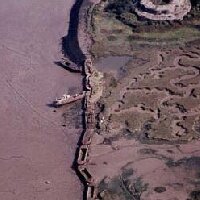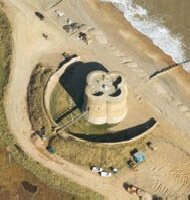Coastal & Marine Heritage

Taking to the Water: English Heritage Initial Policy for the Management of Maritime Archaeology in England

The archaeology of Europe and the place we now call Britain serves to illustrate our communality with the continent, rather than our separateness, in the millennia before rising sea levels severed us from the mainland, about 10,000 years ago. Since then, being on an island has been central to our national identity.
The seas surrounding our coast have served as both a highway and a barrier for many centuries, and their numerous shallow estuaries have been as much an invitation as an impediment to sea-bourne visitors, whether invader, trader, or immigrant. The intimately linked combination of British naval power and interests in maritime trade, led to an Industrial Revolution and Empire which influenced world history.
This heritage is enshrined in our coastal and sub-tidal maritime archaeology, which extends from the submerged remains of prehistoric landscapes, through shipwrecks from every period, the archaeology and built heritage of our major ports and minor harbours, and layer upon layer of coastal defence.
Marine Archaeology
With the passing of the 2002 National Heritage Act, English Heritage assumed responsibilities for marine archaeology below mean low water within English territorial waters, allowing its management to become integrated with that of the terrestrial historic environment.
The organisation’s functions were modified to include:
- Securing the preservation of ancient monuments in, on, or under the seabed;
- Promoting the public’s enjoyment of, and advancing their knowledge of ancient monuments in, on, or under the seabed
The definition of ancient monuments was also amended to include any site comprising, or comprising the remains of, any vehicle, vessel, aircraft or other movable structure or part thereof. Another significant change allowed administrative responsibilities in support of the Protection of Wrecks Act 1973, on a UK-wide basis, to be transferred from the Department of Culture, Media and Sport (DCMS) to English Heritage.
The English Heritage Maritime Team has made significant advances over the past three years against a backdrop of ever-expanding commercial development of the marine environment and a slowly growing understanding of the archaeological potential of what lies within it. Their work is described in England’s Maritime Archaeology: Under the Sea and around the Coast and a policy position is set out in Taking to the Water. English Heritage Initial Policy for the Management of Maritime Archaeology in England (2002). English Heritage also works with the Joint Nautical Archaeological Policy Committee in promoting and developing the Code of Practice for Seabed Developers (1998) and in partnership with the British Marine Aggregate Producers Association in the production of Marine Aggregate Dredging and the Historic Environment: guidance note (2003).
Coastal heritage
Natural erosion, plans, strategies, and schemes associated with flood and coastal risk management, and commercial developments, all threaten important coastal archaeological sites and historic buildings.English Heritage offers advice on the implications of these factors for the historic environment at a strategic and scheme specific level. English Heritage is also commissioning a series of Rapid Coastal Zone Assessment surveys, intended to improve understanding, enhancement of local authority Historic Environment Records (HERs) and conservation of historic remains in the coastal zone.
In 2003, English Heritage published Coastal Defence and the Historic Environment:English Heritage Guidance. This sets out in detail the policies that underpin coastal management and the historic environment, (and how these may be integrated), a summary of the archaeological resource, and guidance on mitigation, directed towards coastal managers and local authority historic environment officers.
The first Government response to the Making space for water consultation exercise, entitled Taking forward a new Government strategy for flood and coastal erosion risk management, was issued in March 2005.In the light of this, the English Heritage 2003 guidance on managing the coastal historic environment will be revised. The basic principles of technical feasibility, long-term sustainability, and cost effectiveness will continue to underpin English Heritage’s approach when collaborating in the development of schemes to protect the historic environment, or to mitigate damage.
Further Information
The Aggregates Levy Sustainability Fund (ALSF) is distributed on behalf of Defra by English Heritage and other organisations. This includes a ring-fenced allocation for marine initiatives which is to be distributed by English Heritage, English Nature and CEFAS.
The National Monuments Record (NMR) is the public archive of English Heritage. The NMR contains over 40,000 records of wreck sites and seabed archaeological features, documentary references to marine casualities and fishermen's net fastenings.
Contact the Maritime Archaeology/Coastal policy team at: .
What's New?
-
The National Heritage List for England is now live on the English Heritage website.
-
Welcome to the HER21 page. This page offers access to the full suite of HER21 project reports.
